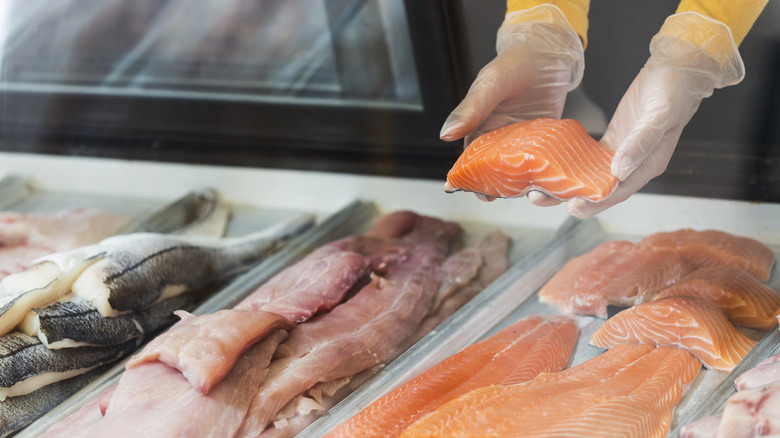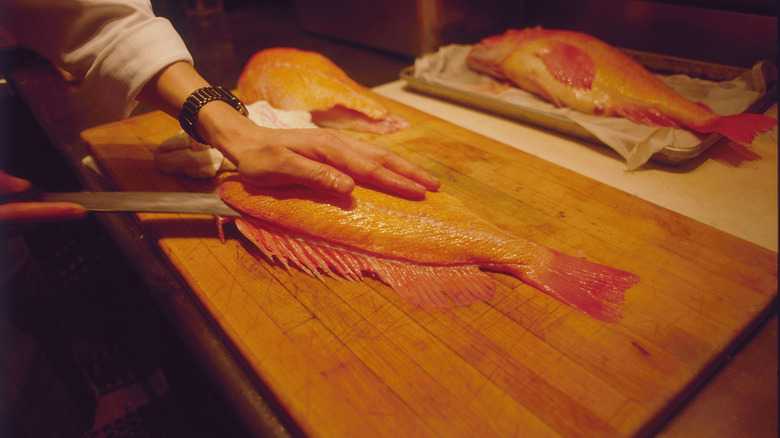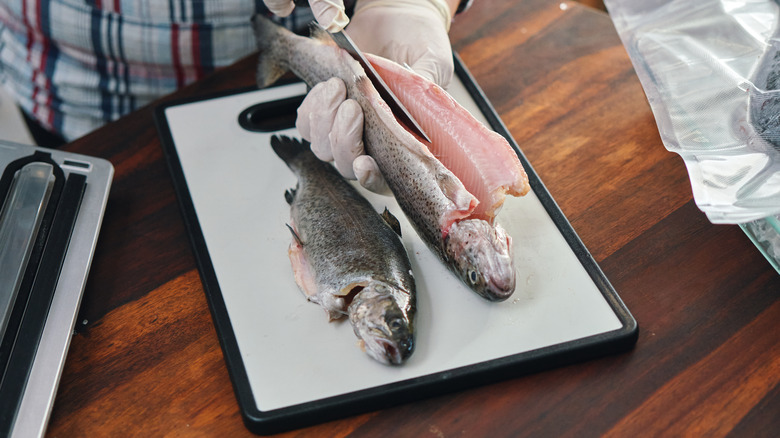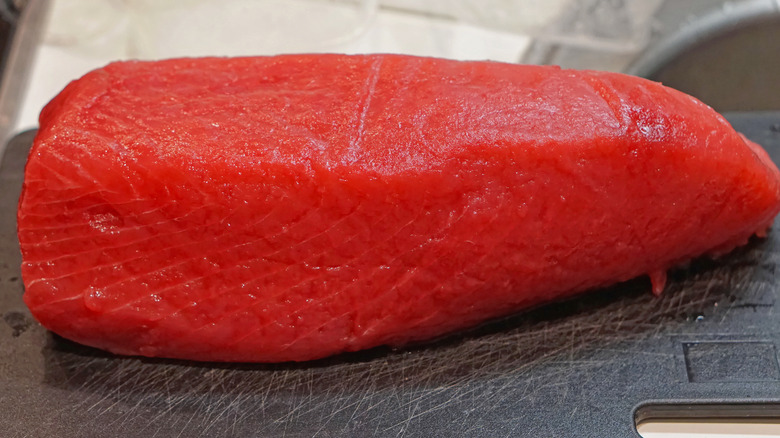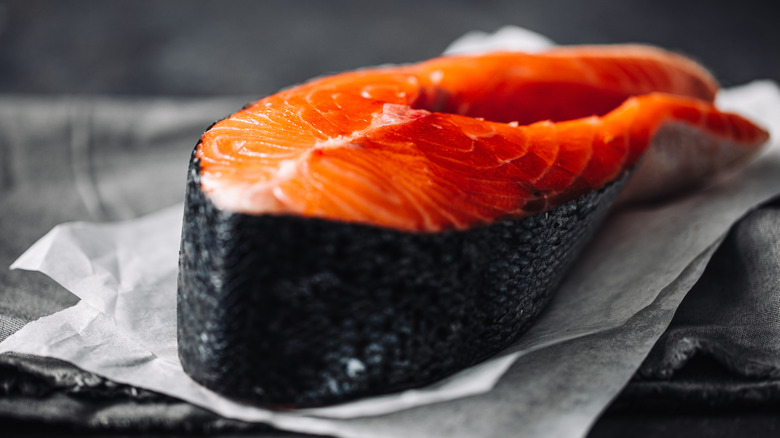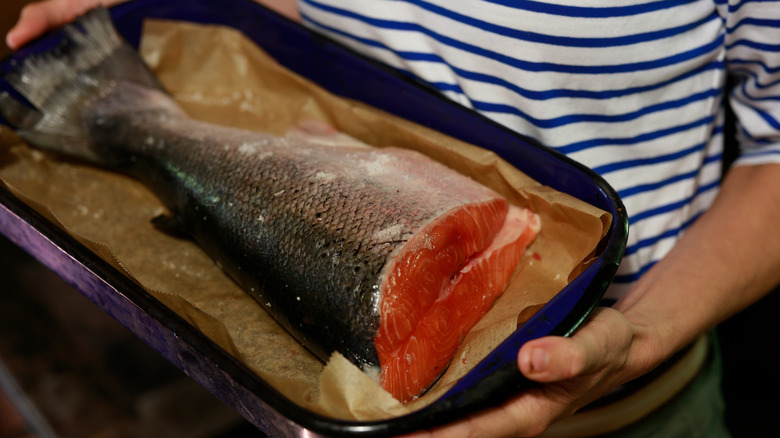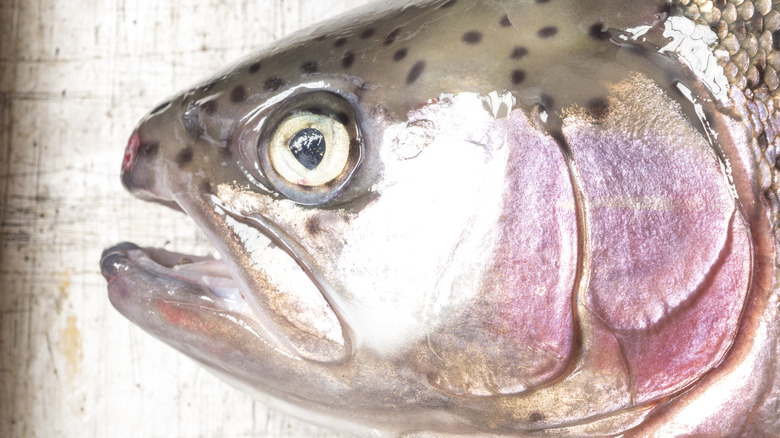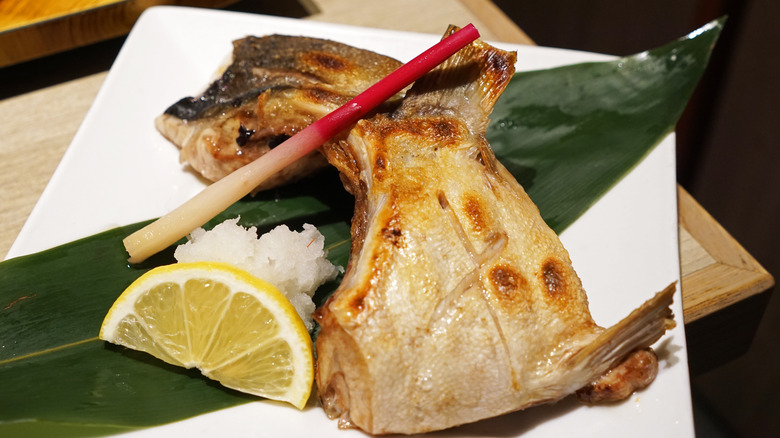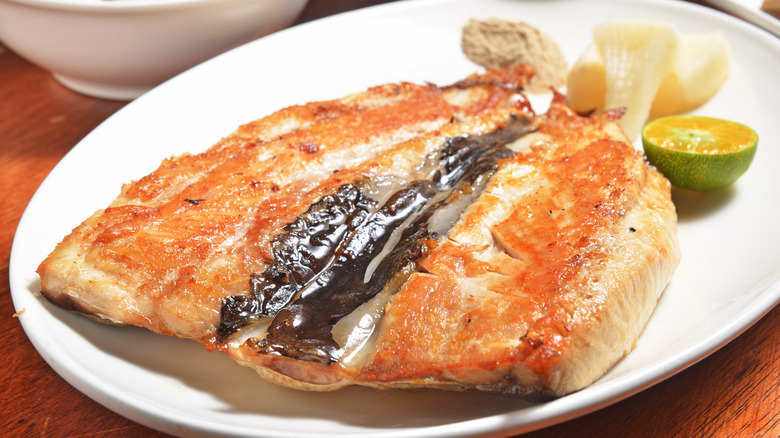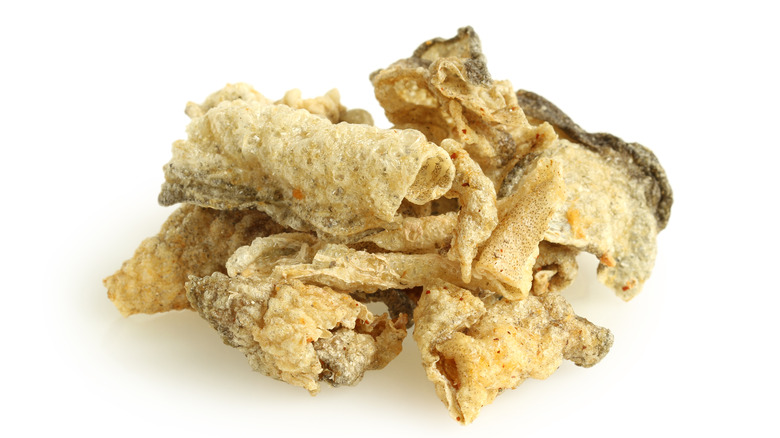9 Cuts Of Fish, Explained
Several considerations drive the techniques we use to cut fish. The size of the fish, the skeletal structure, the meat density, and the cooking method are a few of the factors that come into play when deciding which way to direct a knife when cutting fish. Economics also come into play, and a lot of the fish goes to waste (as does your money) when not fully utilized. Given that, cooking the whole fish is typically the smartest choice, economically, but that's not always possible or preferable.
A couple more things to consider: First, The U.S. Environmental Protection Agency (EPA) estimates that food waste, which includes inefficiently cut fish, contributes as much carbon dioxide to the atmosphere as 42 coal-fired power plants. So, utilizing as much of the fish as possible is part of good stewardship for the Earth. One other piece to keep in mind is that fish are living beings, and you want to respect that by being mindful of the cuts of fish you buy — don't take their life for granted by being wasteful. With that being said, here are some cuts to fish to know about.
Fillet
Part of a fillet's popularity is the lack of bones, making it easy to take the fish from the store to the table without much intervention on your part. The fillet process is relatively straightforward. You cut the fish along the back, on one side of the dorsal fins, then down through the meat, following the ribs until you reach the spine. Turning the knife flat, you break through the pin bones where they attach to the spine, then turn the blade downwards, slicing through the meat to separate the fillet from the skeleton. Then, you cut along the bottom ribs to separate the belly from the fillet, and you can remove the skin if you wish.
You still have to deal with the small pin bones at the head-end of the fillet, and there are even fillet cut choices to make. One way is to remove the bones with a V-Cut, running your knife down either side of the bones in a V-shape and just sliding that piece of meat with the bones away from the fillet. Another choice is the J-Cut, which starts with a V-Cut, but after removing the strip of boney meat, you continue and remove the thin flap of belly meat. A third, more economical way is to pull the pin bones out with a pair of pliers. You can now cut the boneless fillet into portions, if the size dictates, trying to keep them uniformly thick for even cooking.
Butterflied fillet
A butterflied fillet is the reverse of a fillet, where you have the whole fish minus the bones. Butterflying usually happens with smaller fish like trout, bass, or bream. Use a pair of kitchen shears to remove the dorsal fins, and instead of starting at the top of the fish, you start at the bottom and work your way up. You first remove the fin at the back of the belly with a few knife cuts before working your blade upwards along the ribs, breaking through the pin bones, and arriving at the top of the spine where the back of the fish meets it.
You then cut through the spine at the head and tail with your shears and remove it from the fish with shallow knife cuts, taking care not to cut through the skin. We're now left with the pin bones to deal with. With trout and small bait fish, like sardines or anchovies, leaving the pin bones in place is fine; you won't notice them after cooking. For fish with larger skeletons and, generally, fish over 18 inches, you'll want to remove the pin bones with pliers or tweezers.
Your fish is ready for grilling or roasting. This method is also preferred for smoking, as it maximizes the fleshy surface area to catch smoke. You can also remove the head and tail for more even frying if that's your end goal.
Loin
The skeletal structure of some fish makes filleting impractical because the flesh doesn't lie flat against it, having a curved body shape. You can still arrive at a place where you have large, boneless pieces of fish to cut portions. Cutting loins rather than fillets is common with large fish, like tuna or swordfish.
To cut loins from a fish, you start by removing the dorsal and ventral (top and bottom) fins. In some cases, the cutter removes the belly before removing the loins. Much like filleting, you start cutting at the dorsal side, moving your knife down towards the spine and working against the ribs for maximum yield. Here, instead of turning the blade to cut the pin bones, you'll go to the outside of the fish and cut parallel with the spine on the near side of the pin bones, and you can lift the top loin away. Starting at the opposite side of the pin bones, you'll work your blade downwards toward the body cavity in the same manner to remove the bottom loin. After removing the skin from the loins, many people cut out the bloodline, a dark strip that runs close to the spine. You can leave the bloodline in with no adverse effects, but many find it strongly flavored and somewhat off-putting. With that step completed, you can portion the loins by cutting them perpendicularly across the "grain" of the meat, meaning the lengthwise direction of the muscle fibers, to your desired thickness.
Steak
Fish steak can be confusing to purchase. That's because the terminology is thrown around loosely, usually indicating a thick cut of fish suitable for pan-roasting or grilling. Depending on who's using the term, that steak could be boneless or bone-in. By definition, a fish steak is a portion of fish that's cut across the spine, and it contains all the bones that section of fish possesses. Steaks are a common cut for salmon, mackerel, and other fish with similar body shapes. You'll commonly encounter tuna or swordfish "steaks," but in those cases, the steak is a cross-cut portion of the loin and doesn't contain the spine, ribs, or pin bones.
Although their presence has diminished, fish steaks were once more popular because they're easy to cut and cook. Steaks from "tall" fish, for lack of a better word, would be unwieldy for cooking, but a fish that measures 3 to 6 inches from top to bottom is a good steak candidate. Cutting a steak involves removing the fins and head, scaling the fish, and then simply cutting across the body and through the spine. You might encounter some resistance at the backbone, and you can either apply pressure to the knife to break through or wiggle the blade to find a space between vertebrae. From there, grill or pan-roast the steak, flavoring it as you'd like. One added bonus for those who partake, the marrow from the spine bubbles up in cooking fish steaks and is a rare treat.
Tail
To avoid confusion, we're not talking about the finny end part of a fish here. A tail cut is usually a muscular cross-section removed from the carcass, located behind the usable part of a loin or fillet and the tail fins. As the tail muscles get a lot of use, you can expect more flavor intensity from them than center-cut pieces. Tail cuts are typical from more round-bodied fish like tuna, swordfish, or jack. In some cases, the tail encompasses the entire usable part of the body meat, as is the situation with monkfish. Fishmongers typically cut monkfish into portions or medallions after removing the head, making it a bit of an outlier compared to other fishtails.
You can fillet the tail meat off the spine, but it's commonly used as a whole piece. Think of the tail cut as a beef or pork roast. You can slow-roast the tail section, which renders the fish's fat wonderfully, yielding juicier meat. You can also quick-sear it or use the tail in a stew. As a bone-in cut, it's easy to pick the meat from the bones since you're only dealing with the smaller vertebrae at the end of the spine.
Cheek
As nose-to-tail cooking got us eating beef and pork cheeks, so too should we consider fish cheeks. Yes, fish have cheeks, and they're exercised in the same way yours are, by biting and chewing. That exercise lends a different density to the cheeks than the body meat, with a bit more character to the flavor.
To remove the cheeks, poke around the head below, just behind the eye, and above the upper jaw to locate the soft, fleshy patch that is the cheek. Holding your knife at an angle, follow the edge of the boney socket to its bottom, then cut around the perimeter of the socket, forming a sloping cone-shaped cut. The cheek should pop right out at this point. Lay the cheek on the cutting board skin-side down, and laying the knife flat, run it across the inside of the skin to remove it. You only get two quarter-to-silver-dollar-sized cheeks from each fish, so you may want to freeze them and save them up for a bigger project at a later date. Unless you've had a good day fishing, that is. Smaller cheeks are good for sautéing like scallops or frying, while larger cheeks stand up to grilling and pan-roasting quite well.
Collar
Keeping with the whole-fish utilization, we come to the collar. Fish aren't wearing shirts, but the collar comes from the portion along the clavicle and the pectoral fin. They aren't as neat and tidy as a fillet, they have fat, skin, bones, and fins attached, but those factors all add up to delicious, often-ignored meat. The collars are left intact through the usual fillet methods and are often discarded along with the head and cheeks. They're generally cut from bigger fish to provide something more than the morsel a small fish would provide, and, like cheeks, there are only two per fish. So you may want to save them up for something bigger.
There are a few ways to remove the collars. The first is to remove the collars as part of the fillet process, cutting them from the fillet after the whole side gets removed. The second is to cut along the collar at the top of the fish, sawing through the inside gill plate with a serrated knife and then separating the last bit under the jaw with your fillet knife. It's not an elegant process or an elegant piece of fish; think of them as the equivalent of chicken wings, but the sophistication of its flavor makes up for its appearance. Collars stand up to grilling, searing, wok-frying, and sous vide cooking, although the latter benefits from a quick sear to crisp it.
Belly
Okay, now for the last meaty parts of the fish. If you've filleted the fish and you've removed the belly, you can trim it off the fillet for separate use. If you've taken the loins off, there's still some work to do. First, lay the fish belly up on your cutting board. Cut down from one pectoral fin, around the gill plate, to the chin, and then back to the other gill plate and pectoral fin. Now that you've released the front of the belly from the carcass and completed the complicated part, you only need to slide your knife sideways to the back, anterior fin to release the belly in one piece.
Tuna and salmon bellies are prized in sushi-making, as the rich fattiness is even more texturally and flavor-intense than the loin meat. Smaller fish bellies are fantastic when charred on a hot wood grill, much as they are when bathed in cold smoke for several hours. Frying them is also an option. You're not limited to using the belly whole. You can cut the meat from larger bellies, like tuna or wahoo, for easier cooking. These fatty fish bellies take on a velvety texture when poached in olive oil or animal fat.
Offal
There's still food to harvest after all of these techniques. You can separate the liver from the organs of larger fish removed before cutting the rest of the body. Sautéed cod liver is common in French cooking, and cod liver mousse is a Ukrainian staple. Salmon livers are equally tasty, and monkfish liver is known as sea foie gras in European cuisine and is a popular dish in Japan. If you've skinned your fish, their skins can be dehydrated and fried like pork rinds. Salmon skin rolls pair crisp skin with rice, fish, and vegetables before rolling it all in seaweed. Even without the cheeks and collars, the head is still useful for soups and stews, with many cuisines across the world having some variation of the two, from spicy broth-based stews from the Caribbean, South America, and Asia, to creamy, dill-infused soups from Scandinavian countries.
After removing the loins or fillets, the rib bones still have meat between them. You can scrape that meat off for sushi rolls, pasta fillings, or mousses. Slabs of whole smoked fish ribs are an option, or pick the meat from them after they've grilled. With all of this, we haven't even gone down the road of bladders, tongues, eyes, and the like. Finally, when you've run through the gamut of off-cuts, bone picking, and organs, what's left of the fish (hopefully just bones), simmered with some aromatic vegetables and herbs, yields a stock that's good for poaching, soups, or sauces.
